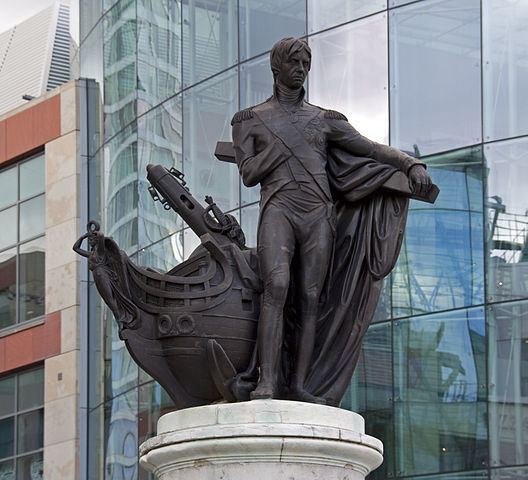Name Richard Westmacott | ||
 | ||
Died September 1, 1856, Mayfair, London, United Kingdom | ||
Sir Richard Westmacott (15 July 1775 – 1 September 1856) was a British sculptor.
Contents

Life and career
Westmacott studied with his father, also named Richard Westmacott, at his studio in Mount Street, Grosvenor Square in London before going to Rome in 1793 to study under Antonio Canova. On returning to England in 1797, he set up a studio, where John Edward Carew and Musgrave Watson gained experience.
Westmacott had his own foundry at Pimlico, in London, where he cast both his own works, and those of other sculptors, including John Flaxman's statue of Sir John Moore (1810–18) for Glasgow. Late in life he was asked by the Office of Works for advice on the casting of the reliefs for Nelson’s Column. He also had an arrangement with the Trustees of the British Museum, which allowed him to make moulds and supply plaster casts of classical sculpture in the museum's collection to country house owners, academies and other institutions.
He exhibited at the Royal Academy between 1797 and 1839. His name is given in the catalogues as "R. Westmacott, Junr." until 1807, when the "Junr." was dropped. He was elected an associate of the Royal Academy in 1805, and a full academician in 1811; his diploma work, a marble relief of Jupiter and Ganymede, is still in the academy's collection. He was professor of sculpture at the academy from 1827 until his death. He received his knighthood on 19 July 1837.
Works
Among his works are the reliefs for the north side of Marble Arch, the sculptures of figures representing The Rise of Civilisation on the pediment of the British Museum, and the Waterloo Vase now in Buckingham Palace Gardens. This enormous urn was sculpted from chunks of marble earmarked by Napoleon for a trophy commemorating his anticipated victory in the Napoleonic Wars and then given to George IV as a gift from the Grand Duke of Tuscany.
His statue of Horatio Nelson, Birmingham was the first statue of Nelson in Britain. There are other monuments to the admiral by Westmacott at Bull Ring, Birmingham, and Barbados, while that at Liverpool was modelled and cast by Westmacott, to a design by Matthew Cotes Wyatt. In Liverpool there is also an equestrian statue of King George III sculpted by Westmacott, which was unveiled in 1822. He was responsible for the statue of the agriculturalist and developer Francis Russell, 5th Duke of Bedford in Russell Square, and the one of the Duke of York on top of the column in Waterloo place. His Achilles in Hyde Park, a bronze copy of an antique sculpture from Monte Cavallo in Rome, is a tribute to the Duke of Wellington, paid for by £10,000 raised by female subscribers.
His sculptures of poetical subjects were in a style similar to those of the contemporary Italian school: his works of this type included Psyche and Cupid for the Duke of Bedford; Euphrosyne for the Duke of Newcastle; A Nymph Unclasping her Zone; The Distressed Mother and The Houseless Traveller.
Westmacott also sculpted the memorials to Pitt the Younger, Spencer Perceval, Charles James Fox and Joseph Addison in Westminster Abbey; and those to Sir Ralph Abercromby, Lord Collingwood and Generals Pakenham and Gibbs in St Paul's Cathedral.
His other sepulchural monuments include those to Lt. General Christopher Jeaffreson (d.1824) in St.Mary's Church in Dullingham; to Commander Charles Cotton (d.1828) at St. Mary's Church in Madingley; to William Pemberton (d.1828) at St Margaret's Church in Newton, South Cambridgeshire; to Sir George Warren (d.1801) at St. Mary's Church, Stockport, Greater Manchester, depicting a standing female figure by an urn on a pillar; and to Rev. Charles Prescott (d.1820), in St. Mary's Church, Stockport, showing a seated effigy.
He created a sculptural group for the marble arch of the Cumberland Gate to Hyde Park.
Personal life
Westmacott lived and died at 14 South Audley Street, Mayfair, London where he is commemorated by a blue plaque. His son, also called Richard Westmacott, followed closely in his footsteps also becoming a notable sculptor, a Royal Academician and professor of sculpture at the academy.
Westmacott is buried in a tomb at St Mary's Church at Chastleton, Oxfordshire, where his third son Horatio was rector in 1878.
